Melibe fimbriata
Alder & Hancock, 1864
Order: NUDIBRANCHIA
Suborder: DENDRONOTINA
Family: Tethydidae
There is some confusion over the identity of these larger Indo-West pacific species of Melibe. Elsewhere on the Forum I have suggested that the oldest name for this species is Melibe viridis. However one 'species' has migrated through the Suez Canal into the Mediterranean where it is almost always identified as Melibe fimbriata. Until the taxonomic uncertainty is resolved I am listing Mediterranean records here under that name.
References:
• Despalatovic, M., Antolic, B., Grubelic, I. & Zuljevic, A. (2002) First record of the Indo-Pacific gastropod Melibe fimbriata in the Adriatic Sea. Journal of the Marine Biological Association of the United Kingdom, 82(5): 923-924.
• Moosleitner, H. (1986) Note on the occurrence of Melibe sp. (?) in the Mediterranean (Opisthobranchia: Fimbriidae). La Conchiglia, 18(202-203): 20.
• Thompson, T.E., Crampton, D.M. (1984) Biology of Melibe fimbriata, a conspicuous opisthobranch mollusc of the Indian Ocean, which has now invaded the Mediterranean Sea. Journal of Molluscan Studies, 50(2): 113-121.
Rudman, W.B., 2004 (February 12) Melibe fimbriata Alder & Hancock, 1864. [In] Sea Slug Forum. Australian Museum, Sydney. Available from http://www.seaslugforum.net/find/melifimb
Related messages
Melibe from Tunisia
March 25, 2009
From: Rym Zakhama-Sraieb

Dear Bill,
I found this species in Kerkennah Island (south of Tunisia) in 20 cm depth. The size of specimen is about 8 cm. It looses their cerata when we add formol. I'm not sure but I think that it's a sea slug; could you help me to identify it?
Thanks
Best regards
Rym Zakhama-Sraieb
Unité de Recherche de Biologie Animale
et Systématique Evolutive
2094, Campus Universitaire, Manar II,
Faculté des Sciences de Tunis
Tunisie
zakhamarym@yahoo.fr
Zakhama-Sraieb, R., 2009 (Mar 25) Melibe from Tunisia. [Message in] Sea Slug Forum. Australian Museum, Sydney. Available from http://www.seaslugforum.net/find/22364
Dear Rym,
It is a bit difficult to make out much detail from your photos but from its size and general shape, I am pretty sure it is what we are calling Melibe fimbriata. Have a look at the species' Fact Sheet and the attached messages for more information. If you want to try photographing this species again, it might be an idea to keep it in a container without two large crabs. Melibe will cast its cerata at the slightist disturbance and large crabs would certainly disturb it!
Have a look at the other species of Melibe on the Forum as they are very fascinating animals, using their large oral hood to catch small crustacea.
Best wishes,
Bill Rudman
Melibe 'fimbriata' from Cyprus
July 20, 2007
From: Felix Sanchez Villarejo


Dear Bill
I found this curious sea slug diving in Larnaka harbour, in the Cyprus south coast.I believe it is a Lessepian migrant because I can´t found it in a Mediterranean guides. It look like aplysiid but I´m not sure.
Locality: Larnaka Harbour, 8 meters, Cyprus, eastern Mediterranean, 15 may 2007, In sandy and muddy bottom. Length: 20 cm more or less. Photographer: Felix Sanchez.
It has a very curious extended mouth, and was eating by filtering the sandy bottom. I would like to know the name of this animal.
If somebody would like, I have a video of this eating, is very interesting.
Best wishes.
Felix Sanchez
felixsv@hotmail.com
Sanchez Villarejo, F., 2007 (Jul 20) Melibe 'fimbriata' from Cyprus. [Message in] Sea Slug Forum. Australian Museum, Sydney. Available from http://www.seaslugforum.net/find/20207
Dear Felix,
Your animal is a lessepsian migrant from the Indian Ocean and as you will see from the relevant Fact Sheet I am calling it Melibe fimbriata because that is what it has previously been identified as in the Mediterranean. I suspect though that it is Melibe viridis. If you look at the earlier messages and information on other species of Melibe on the Forum you will see that these animals have lost their teeth and their ability to bite, and feed by using their greatly enlarged 'oral hood' as a sort of fishing net, detecting small crustacea (shrimps, small crabs, prawns etc) by the sensitive hair-like papillae around the edge of the oral hood. In your photo alongside we have a nice view of what a prey shrimp would see just before its caught.
Best wishes,
Bill Rudman
Re: Melibe from the Adriatic
March 1, 2004
From: Goran Jancic
Dear Bill!
Thank you so much for your message [#2280]. I've been writing to many addresses but you are the first one who helped me. Since only few people in Serbia and Montenegro are interested in this matter, it's very difficult to find any literature which makes your help more appreciated.
Goran Jancic
njivice@yahoo.com
Jancic, G., 2004 (Mar 1) Re: Melibe from the Adriatic. [Message in] Sea Slug Forum. Australian Museum, Sydney. Available from http://www.seaslugforum.net/find/12339Re: Melibe from the Adriatic
February 27, 2004
From: Thierry Thibaut
Concerning the recent message about Melibe fimbriata in the Adriatic [#12280], I recommend the following paper concerning the first report of Melibe fimbriata in Croatia :
• Despalatovic, M., Antolic, B., Grubelic, I. & Zuljevic, A. (2002) First record of the Indo-Pacific gastropod Melibe fimbriata in the Adriatic Sea. Journal of the Marine Biological Association of the United Kingdom, 82(5): 923-924.
Thierry
thibautt@unice.fr
Thibaut, T., 2004 (Feb 27) Re: Melibe from the Adriatic. [Message in] Sea Slug Forum. Australian Museum, Sydney. Available from http://www.seaslugforum.net/find/12323Thanks Thierry,
Bill Rudman
Melibe from the Adriatic
February 26, 2004
From: Goran Jancic
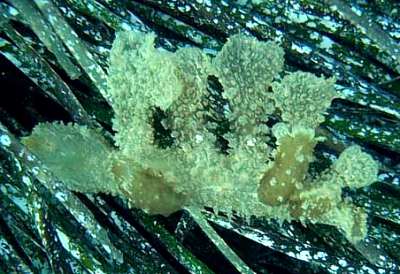
I am writing in the hope that you can help me in identifying what species of slug this is.
The photo was taken in the Adriatic Sea, near Herceg Novi, Boka Kotorska Bay, Montenegro. Depth of 8 meters, September 2003.
Sincerely,
Goran Jancic
njivice@yahoo.com
Jancic, G., 2004 (Feb 26) Melibe from the Adriatic. [Message in] Sea Slug Forum. Australian Museum, Sydney. Available from http://www.seaslugforum.net/find/12280Dear Goran,
This is a species of Melibe. This species is considered to have entered the Mediterraean through the Suez Canal as a Lessepsian migrant. At present it has been identified as Melibe fimbriata, but as I discuss on that Fact Sheet, its true name is problematic until we sort out just how many species there are in the Indo-West Pacific.
Best wishes
Bill Rudman
Melibe fimbriata - egg ribbon
February 14, 2004
From: Andrej Jaklin
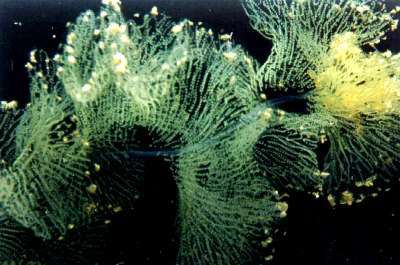

Dear Bill,
Here is a slide of an egg mass of Melibe fimbriata from the middle part of the Adriatic Sea. It was attached only with basal part (= beginning?) to detritus, and all the rest was free. The total length was around 5 cm. Unfortunately, direction is not clear and I forgot to take a note about that during that night dive. So at the moment it's just a small piece of information and the next time I'll be more thoughtful in obseration.
Best regards,
AJ
jaklin@cim.irb.hr
Jaklin, A., 2004 (Feb 14) Melibe fimbriata - egg ribbon. [Message in] Sea Slug Forum. Australian Museum, Sydney. Available from http://www.seaslugforum.net/find/12104Thanks Andrej,
These animals that live in soft substrates are special problems with laying their eggs and attaching them. It looks like the animal has found an algal filament to attach the egg ribbon to.
I have previously identified this animal as Melibe viridis as I think that is probably the oldest name for this large Indo-West Pacific species. However since Mediterranean have always been identified with Melibe fimbriata I have all the Mediterranean records of this species on the Forum to a Melibe fimbriata Page. It is still not clear to me just how many of these big Melibe species there are in the Indo-West Pacific. Hopefully soon to be published research will clarify the situation.
Best wishes
Bill Rudman
Swimming Melibe from Turkey
March 21, 2003
From: Haluk Akbatur
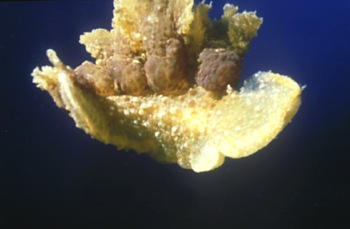
Dear Bill,
I have some difficulty in identifying this pelagic opistobranch. Is it a Melibe species? It is from the Mediterranean coast of Turkey;
Size: 25cm,
Depth: 7m.
Place: Kaþ, Antalya
Date: 25 June 2000
Thanks,
Haluk Akbatur
lasergoz@ttnet.net.tr
Akbatur, H., 2003 (Mar 21) Swimming Melibe from Turkey. [Message in] Sea Slug Forum. Australian Museum, Sydney. Available from http://www.seaslugforum.net/find/9411Dear Haluk,
Yes this is a species of Melibe. As you will see from my comments to earlier messages I have some difficulty in identifying these large Melibe to species. Although your animal is apparently free-swimming, it normally lives on the sea floor crawling along on its foot.
Best wishes,
Bill Rudman
Melibe from Turkey
January 25, 2003
From: Ferda Buyukbaykal
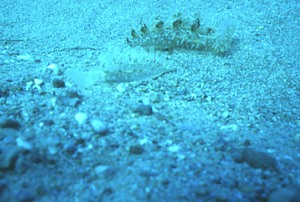
Dear Bill,
Could you identify these animals?
enough for you.
Image Data: Manavgat, Antalya, Turkey. June 1997, dil kumu, 8mt / 10-14cm, sandy.
Best wishes
Ferda
ferdabbaykal@isnet.net.tr
Buyukbaykal, F., 2003 (Jan 25) Melibe from Turkey. [Message in] Sea Slug Forum. Australian Museum, Sydney. Available from http://www.seaslugforum.net/find/8891Dear Ferda,
The two animals are a bit hard to see but the way they hold their cerata upright suggest they are a species of Melibe rather then the endemic Tethys fimbria. If so I think the most likely identification is Melibe viridis, an Indo-West Pacific species which has apparently invaded the Mediterranean via the Suez Canal [Lessepsian migrant].
Best wishes,
Bill Rudman
Another Melibe from Turkey
December 6, 2001
From: Baki Yokes
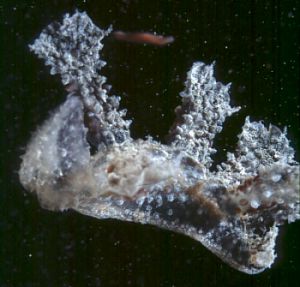
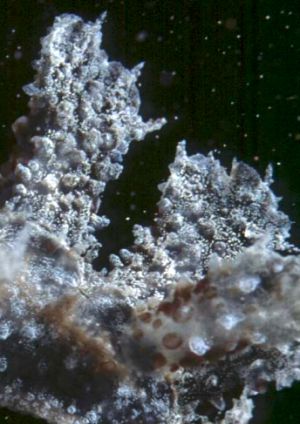
Dear Bill,
Following Peter van Bragt's earlier message, here is another Melibe specimen from Turkey, photographed during a night dive on sand. Is it Melibe viridis?
Photo:
Place: Antalya, Turkey
Divesite: Tekirova
Depth: 6m
Size: approx. 7cm
Photo: Adnan Buyuk: ado2000tr@yahoo.com
Best wishes
Baki
bakiyokes@turk.net
Yokes, B., 2001 (Dec 6) Another Melibe from Turkey. [Message in] Sea Slug Forum. Australian Museum, Sydney. Available from http://www.seaslugforum.net/find/5678Dear Baki,
Thanks for the photo of this swimming Melibe. I am sure this is the same species as the one reported by Thompson & Crampton (1984) in large populations from Greece. It is certainly an immigrant from the Red Sea / Indian Ocean. The problem is giving it a name. As I said in reply to Peter Van Bragt's message, the problem is the lack of information we have on variation within populations. Species of Melibe have no radula and they are rather uniformly coloured with drab brown and opaque white, so the two most useful characters in nudibranch identification are not available to us.
Differences which have been used are shape of cerata, degree of development of gills and papillae, and colour. While some species, such as Melibe leonina and Melibe rosea are very distinctive, separating many species is very difficult. Until more studies are done on populations of these animals so we better understand how they change shape and colour as they grow from juveniles to adults, I think out identifcations will involve a considerable amount guesswork.
Best wishes,
Bill Rudman
Melibe from Turkey
March 7, 2001
From: Peter H. van Bragt
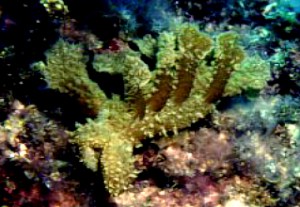
Hello Bill,
This summer a friend of mine (Eddy Zandt) came back from a diving trip in the Mediterranean sea at Turkey. He made the enclosed photographs of a large and swimming seaslug. After some searching I ended up with Melibe fimbriata as a possible determination of the species name.
Can you confirm this???
Thanks and with best regards
Peter H. van Bragt
vanbragt.phjm@hsbrabant.nl
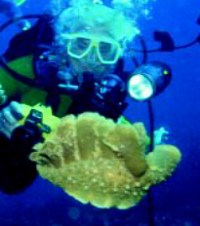

Dear Peter,
Thompson & Crampton (1986) and Moosleitner (1986) record this species from the Ionian Sea, Greece. It is considered to have entered the Mediterranean from the Indian Ocean through the Suez Canal as the genus Melibe does not occur naturally in the Mediterranean. Thompson & Crampton identified their animals with Melibe fimbriata but as I have suggested above, Melibe viridis is probably the earliest name for this species.
It grows to quite a large size, Moosleitner's largest animal being more than 30cm long. From Eddy Zandt's photo, it looks like his specimen was also quite large.
• Moosleitner, H. (1986) Note on the occurrence of Melibe sp. (?) in the Mediterranean (Opisthobranchia: Fimbriidae). La Conchiglia, 18(202-203): 20.
• Thompson, T.E., Crampton, D.M. (1984) Biology of Melibe fimbriata, a conspicuous opisthobranch mollusc of the Indian Ocean, which has now invaded the Mediterranean Sea. Journal of Molluscan Studies, 50(2): 113-121.
Best wishes,
Bill Rudman
